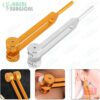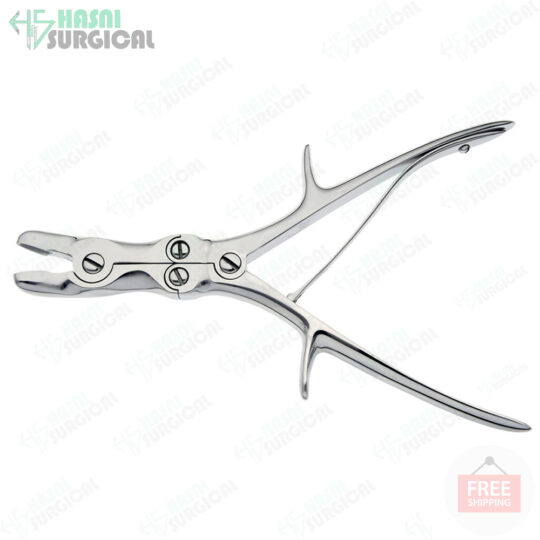Description
Healing Therapy Medical Surgical Diagnostic Instruments: German Grade Testing Tuning Fork
- Overview of Tuning Forks in Medicine:
- Tuning forks are commonly used in the medical field as diagnostic tools for evaluating hearing loss.
- Known for their precise frequency and sound, German-grade forks are considered the highest quality for medical purposes. These instruments are often used by healthcare professionals for their ability to produce consistent, reliable vibrations.
- Purpose of the Rinne Test:
- The primary use of tuning forks in hearing assessment is for the Rinne test, which is a diagnostic procedure used to differentiate between conductive and sensorineural hearing loss.
- The Rinne test helps to determine how well sound waves are being conducted through the ear and bones, allowing doctors to assess potential hearing issues.
- How the Rinne Test is Performed:
- Step 1: The doctor first strikes the tuning fork to produce a humming sound.
- Step 2: The vibrating tuning fork is then placed near the patient’s skull, typically on the mastoid bone behind the ear.
- Step 3: The doctor asks the patient to signal when they can no longer hear the sound through the bone conduction.
- Step 4: The doctor quickly moves the tuning fork near the patient’s ear canal.
- Step 5: The patient is asked to report when they can no longer hear the sound through air conduction.
- Step 6: The doctor times how long the patient can hear the sound through the skull and the ear using a stopwatch.
- Understanding the Results:
- Normal Hearing (Positive Rinne test):
- In a normal hearing test, the patient should hear the tuning fork louder and longer when it is placed near the ear canal (air conduction) than when placed near the skull (bone conduction).
- This indicates that the ear is conducting sound through air more efficiently than through bone.
- Conductive Hearing Loss (Negative Rinne Test):
- If the patient hears the sound more through the skull or jaw than through the ear, it may indicate conductive hearing loss. This type of hearing loss occurs when there is an obstruction or damage in the outer or middle ear, which affects the transmission of sound vibrations.
- Sensorineural hearing loss:
- In some cases, if the test shows both air and bone conduction are impaired, it could indicate sensorineural hearing loss, which involves damage to the inner ear or auditory nerve.
- The test helps identify whether the hearing loss is due to a conductive or sensorineural problem.
- Normal Hearing (Positive Rinne test):
- Other Uses of Tuning Forks in Medicine:
- While primarily used for hearing tests, tuning forks have other applications in healthcare:
- Vibration Testing: Tuning forks can be used to test for sensory nerve function. For example, they can be applied to the feet or hands to check for neuropathy, as patients with nerve damage might not be able to perceive the vibrations.
- Fracture Detection: In cases of suspected bone fractures, tuning forks can help doctors assess if a bone is broken. The vibrations of the fork can highlight pain or sensitivity, which is indicative of a fracture.
- Joint Movement and Muscle Therapy: Tuning forks can also be used in some therapeutic practices to promote healing by stimulating tissue and improving circulation. Their vibrations may help relax muscles and relieve pain.
- Infection Detection: The sensitivity of the fork’s vibration can also aid in diagnosing conditions related to joint inflammation or infections in the body.
- While primarily used for hearing tests, tuning forks have other applications in healthcare:
- Benefits of Using German Grade Forks:
- Precision and Reliability: German-grade tuning forks are manufactured with high standards, ensuring accurate and consistent frequency production. This precision is critical in medical diagnostics.
- Durability: These tuning forks are built to withstand frequent use and are made from high-quality materials, making them long-lasting and resistant to wear.
- Standardized Testing: Using a high-grade instrument ensures that healthcare professionals perform the Rinne test with the same reliability and consistency, minimizing potential errors in diagnosis.
- Comfortable for Patients: German-grade tuning forks are designed to produce a smooth and stable vibration, which makes the procedure more comfortable for patients.
- Conclusion:
- Tuning forks, especially those of German-grade quality, are invaluable diagnostic tools in the medical profession, particularly for evaluating hearing loss and other health conditions.
- The Rinne test is just one example of how these simple yet effective instruments can provide critical insights into a patient’s health, helping doctors make accurate diagnoses and improve patient care.







































Reviews
There are no reviews yet.